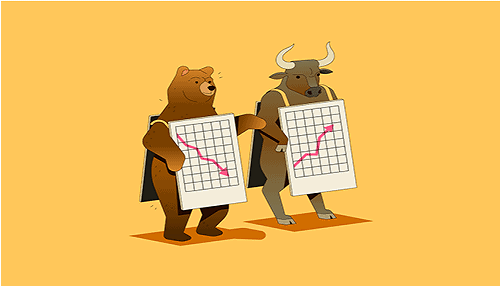Bear Market vs. Bull Market

Markets experiencing sustained and/or substantial growth are called bull markets.
Markets experiencing sustained and/or substantial declines are called bear markets.
Each one comes with its own unique mix of advantages and disadvantages.
When researching cryptocurrencies, stocks, real estate, or any other asset, you’ll often come across descriptions of the market in one of two ways: as a bull market or a bear market.
To put it another way, a bull market is one in which prices are increasing, while a bear market is one in which prices are decreasing.
Because markets often experience day-to-day (or even moment-to-moment) volatility, both terms are generally reserved for:
- Longer periods of mostly upward or downward movement
- Substantial upward or downward swings (20% is the widely accepted figure)
What is a bull market?
A bull market, also known as a bull run, is a period of time during which the majority of investors are purchasing, demand exceeds supply, market confidence is at an all-time high, and prices are rising. If you observe that prices in a particular market are quickly moving in an upward direction, this could be an indication that the majority of investors are becoming optimistic or “bullish” about the price increasing further, and it could also mean that you are looking at the beginning of a bull market.
“Bulls” are investors who have the expectation that current prices will rise at some point in the future. As the confidence of investors grows, a positive feedback loop is created. This loop has the tendency to attract further investment, which then causes prices to continue to climb.
Because the level of public confidence in a certain asset has a significant impact on the price of that asset, one tactic that some investors do is to attempt to ascertain the level of optimism that investors have for a particular market. This method is referred to as “market sentiment.”
What marks the end of a bull market?
There will be swings, dips, and corrections along the road even during a bull market. This cannot be avoided. It is also uncommon for people to incorrectly perceive short-term price changes as signaling the end of a bull market. Because of this, it is essential to examine the price action across longer time periods in order to search for any possible signals that a trend may be about to reverse. (Investors that have a shorter time horizon often use the phrase “buying the dip” to describe their strategy.)
The lessons of history have taught that bull markets can not continue indefinitely, and at some point, investor confidence will begin to decrease. This might be brought on by anything from unpleasant news, such as unfavorable legislation, to unanticipated events, such as the COVID-19 epidemic. The beginning of a bear market may be signaled by a sudden and significant drop in price. In a bear market, an increasing number of investors feel that prices will continue to drop, which leads to a negative cycle as investors sell their holdings in an effort to avert additional losses.
How to trade in a bull market
The fundamental concept underpinning investing in bull markets is one that is easily understood. Since prices are rising, going long and buying on price falls is a strategy that is usually seen to be sensible. Because of this, the buy-and-hold strategy as well as dollar-cost averaging are often effective choices for participating in long-term bull markets.
A popular proverb says something like this: “The trend is your friend, until it’s not.” This simply indicates that it is prudent to trade in the same direction as the direction in which the market is trending. On the other hand, no trend will continue indefinitely, and successful execution of one strategy during one phase of a market cycle does not guarantee success in later phases. The only thing that can be said for definite is that the markets may and will shift. Multiple-year bull markets may be wiped out in only a few short weeks, as we saw with the COVID-19 outbreak earlier this year.
In a bull market, it is only natural for most investors to have an optimistic outlook. This makes perfect sense given that prices are up; hence, people’s attitudes should be optimistic generally. However, even when the market is rising, there will always be those who have a negative outlook. It is possible for them to achieve success with short-term bearish bets such as shorting if their trading approach is designed to account for this possibility.
In a bull market, this means that some traders may attempt to sell below the most recent highs. However, they are complex methods, and in most cases, expert traders are the best candidates for using them. When you have less trading expertise, it is often more prudent to trade in accordance with the direction of the trend. Many investors find themselves in a difficult situation when they attempt to short bull markets. After all, putting oneself in harm’s way by walking in front of a charging bull or a train engine is not something to be taken lightly.
What is a bear market?
Bear markets are periods of time characterized by declining prices, poor investor confidence, and a supply that is larger than the demand for the asset being traded. Bears are a term used to describe investors with a pessimistic outlook who anticipate that market prices will continue to decline. Trading in bear markets may be challenging, especially for traders with little to no prior expertise.
Rebounding is typically a slow and unpredictable process that can be influenced by a large number of external factors such as economic growth, investor psychology, and world news or events. It is notoriously difficult to predict when the bear market might end and when the bottom price has been reached.
However, this also means that possibilities may arise. Buying during a bear market may be profitable in the long run, particularly if your investing approach is focused on the medium to long term rather than the short term. Investors who focus on the shorter term should also keep an eye out for transitory price surges or corrections. In addition, there are tactics available for more experienced investors, such as short selling, which is a kind of wagering that the value of an asset will decrease over time. Another method that a lot of people who invest in cryptocurrencies use is called dollar-cost averaging. This involves investing a certain amount of money — let’s say $50 — on a regular basis, regardless of whether the value of the asset is going up or down. This helps to spread your risk and gives you the ability to invest during both rising and falling market conditions.
How to trade in a bear market
In a bear market, one of the easiest methods that traders may use is to maintain a position in fiat money (or stablecoins). If you are not comfortable with prices going down, it may be best for you to wait until the market is no longer in a bear market region before making any major financial decisions. In the event that it is anticipated that a new bull market will emerge at some time in the foreseeable future, you are in a position to profit from it once it appears. On the other hand, if you are HODLing for the long term and have an investing time horizon of several years or decades, a bear market isn’t always a straight warning to sell your holdings right away.
When it comes to trading and investing, it’s often a good idea to trade in the same direction that the market trend is moving in. Because of this, one alternative profitable technique in bear markets might be to establish short bets. [Citation needed] Traders will be able to benefit from falling asset values by conducting their business in this manner. These trades might be day trades, swing trades, or position trades, but the primary objective is to simply trade in the same way as the trend is moving. In light of this, many traders who use a contrarian strategy hunt for “counter-trend” trades, which are transactions that go in the opposite direction of the market’s dominant trend. First, let’s examine how well that works.
This would mean taking a long position on a rebound in the event that the market was in a bearish state. This trend is also known as a “dead cat bounce,” which is another name for a “bear market rally.” These price movements against the trend may be famously unpredictable due to the fact that a large number of traders may seize the chance to long a short-term rebound. However, until it can be shown that the current bear market as a whole has ended, the expectation is that the downward trend will continue immediately following the recovery.
Because of this, savvy traders will take their winnings (around the recent highs) and quit the market before the bear trend starts back up again. In such case, they run the risk of being unable to get out of their long position while the bear market persists. As a result of this, it is essential to keep in mind that this approach entails a significant amount of danger. When attempting to catch a falling knife, even the most experienced traders run the risk of incurring substantial losses.
Where did these “bull” and “bear” terms come from, anyway?
It is unclear where this phrase came from, much like the case with many other financial terminology. The majority of people, however, think that they originate from the manner in which each animal strikes. For example, bulls shove their horns forward, while bears swipe their claws downward. The terminologies’ etymologies have been the subject of speculation and investigation for an extremely extended period of time. This Merriam-Webster explanation is a nice place to begin if you are intrigued about the subject.





















